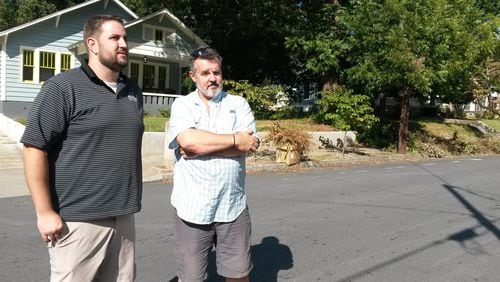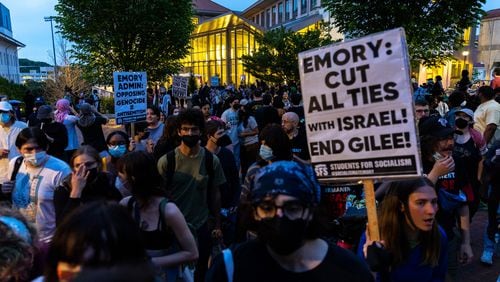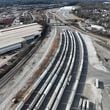Find Matt on Facebook (https://www.facebook.com/mattkempnercolumnist) and Twitter (@MattKempner) or email him at mkempner@ajc.com.
Other Kempner's Unofficial Business columns: http://www.myajc.com/flist/business/unofficial-business-column-matt-kempner/f9y/
Two guys in an SUV idled at the curb of a south Atlanta neighborhood, where residents tell me gunshots still pop at night and the homes have charm but also bars on the windows.
David Witte and Mike Pappas, like a lot of other people I talked to, were hunting for deals on homes near a future stretch of the Atlanta Beltline before the market prices them out.
Witte is a general contractor from Roswell. Pappas, a Decatur real estate agent, was helping him look for houses to buy, fix and either sell or rent out.
Witte, who grew up in the city, normally avoids this part of Atlanta, with all the past reports of crime and blight. But Pappas told him, “The Beltline is the best thing to happen to Atlanta since the Olympics.”
Who hasn’t heard about the wild demand to live along the eastside section that’s already up and running?
Now, more people with a dream to own a home (or to flip one) want in on the action farther from the boom areas. Particularly in lower-income and sometimes blighted neighborhoods where the planned 22-mile loop’s concrete trails aren’t built yet.
Revitalization is a glorious thing. But the Beltline may not work as beautifully when it swings into grittier areas. And it comes with a cost if it does: Plenty of people will be priced out of the market.
Beautiful houses
Midway through an afternoon house scouting trip, Witte told me he liked the diverse group of residents he saw. And the houses, oh, those beautiful houses.
“I’d much rather rehab here then do spec building on 40 acres” in the suburbs, he said. “People love the floors that creak … the windows with the wavy old glass.”
On some streets they hit the gas to get through quick. On others, such as those in Adair Park south of the Atlanta University Center, they said they saw the potential for change that promoters have promised for years.
“I’m gaga over the Beltline,” Pappas said. He told me he’s trying to save enough to buy property while the getting is good. Like a renovated three-bedroom house that he said sold for $48,000 earlier this year. Others are above $100K. “It’s not going to last long.”
That’s the kind of talk that makes peoples’ wallets itch.
For years, big swaths of the city, particularly in the west and south, struggled to attract buyers. Now, prospective buyers I spoke with think prices might get out of their reach in the next year or two.
Of course, they could be wrong.
Real estate is cyclical. Some homes haven’t returned to pre-recession values, despite big predictions in the past.
And while the Beltline has helped fuel growth in the city’s already hot northeast, it may not do the same along the full route.
Only seven of the Beltline's planned 22 miles of trails, greenspace and transit have opened. Now, crews are extending that northeastern leg south to Kirkwood Avenue. It's slated to open next summer, a few months before completion of a three-mile western section.
All this should be a beautiful, happy thing. Government grabbed onto an innovative project funded largely by a special taxing district. Communities previously treated like crud have a new shot at revitalization. Neighbors might profit on their homes.
Word creep
Too bad the word gentrification has crept into the picture.
As newcomers boost property values, long-time residents could be pushed out by rising property taxes and soaring rents. Actually, instead of “could be,” make that “will be.”
It’s hard to go against the forces of a free market.
Rental prices have been on the rise across the city.
Rates in several of the Beltline’s west and southside communities have grown more slowly than those for the city overall, according to figures that Zillow compiled for me. But in others, like Chosewood Park (which, by the way, is around the federal penitentiary), Peoplestown, Adair Park and Bankhead, rents have risen faster than average.
Local government and Beltline offices direct area residents to assistance programs and offer lower-income people funding for down payments or home rehab projects. The Beltline also has helped subsidize developments offering affordable units.
And under a new city ordinance, developers that accept city incentives must make 10 to 15 percent of residential units affordable to people with incomes below 60 or 80 percent of the area’s median.
All this was supposed to make it easier to reach the Beltline’s goal of adding 5,600 affordable units within the project’s tax allocation district by 2030.
But a decade into the project, just 550 have been built, according to Atlanta Beltline Inc. Another 800 are expected in the next five years.
I’ll do the math: It’s way behind.
‘A high bar’
Ryan Gravel, who devised the Beltline idea while working on his master's degree at Georgia Tech, recently resigned from the Atlanta Beltline Partnership board, saying he wants to push more aggressively for affordable housing.
“We need to set a high bar. We should try to do the best that we can,” he told me. “At a minimum we can help people manage that transformation.”
The challenge is figuring what works without messing with property rights or raising fairness issues. I doubt the city would enact outright rent controls or limit property tax increases specifically in gentrifying neighborhoods.
Which leads me to Willie Wright’s front porch in Adair Park, near where the Beltline is planned.
Wright has lived in the house more than half of her 67 years. She wants the Beltline to boost property values. And what if her taxes go up? She’d be happy to sell and move to the country, she told me. “That would be a good thing for me.”
But not for her neighbor Tonya Williams, who stays in a leased three-bedroom house. The rent rose $100 a month this year, to $955. The landlord blamed tax increases, Williams said.
“There’s not too many affordable places anymore.”
About the Author







